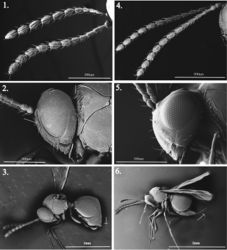Leptopilina decemflagella
| Notice: | This page is derived from the original publication listed below, whose author(s) should always be credited. Further contributors may edit and improve the content of this page and, consequently, need to be credited as well (see page history). Any assessment of factual correctness requires a careful review of the original article as well as of subsequent contributions.
If you are uncertain whether your planned contribution is correct or not, we suggest that you use the associated discussion page instead of editing the page directly. This page should be cited as follows (rationale):
Citation formats to copy and paste
BibTeX: @article{Lue2016JournalofHymenopteraResearch, RIS/ Endnote: TY - JOUR Wikipedia/ Citizendium: <ref name="Lue2016Journal of Hymenoptera Research">{{Citation See also the citation download page at the journal. |
Ordo: Hymenoptera
Familia: Figitidae
Genus: Leptopilina
Name
Leptopilina decemflagella Lue & Buffington sp. n. – Wikispecies link – ZooBank link – Pensoft Profile
Diagnosis
Female Leptopilina decemflagella (Figs 38–39) are immediately distinguishable from other North Eastern US Leptopilina females by having 10 flagellomeres (Fig. 1). There are also several additional characters that separate this species from other Leptopilina; this species has an obvious vertical carina adjacent to the ventral margin of the antennal socket (Fig. 2); this character is not found in other Leptopilina species in the Eastern US. Finally in the lateral view, the hypopygium of Leptopilina decemflagella is pointing ventrally (Fig. 3); in other Leptopilina species their hypopygium is pointing upwards (Fig. 6). Male diagnostic characters are lacking as males for this species are as of yet unrecorded.
Description
Coloration with head, mesosoma, metasoma black, legs light brown. Vertical carina adjacent to ventral margin of antennal socket present. Malar sulcus present. Apical segment of maxillary palp more than 1.5 times as long as preceding segment. Terminal flagellomere with three basiconic sensillae. Basiconic sensillae present on F5-F10. Female antenna composed of 10 flagellomeres. Placoidal sensilla present on F6-10. Number of ridges on pronotal plate in lateral view 3. Sculpture on mesoscutum absent, entire surface smooth, shiny. Subpleuron entire smooth, anteriorly with transversely striate. Dorsal surface of scutellum foveate-areolet. Circumscutellar carina present, incomplete, laterally delimiting dorsal and ventral halves of scutellum, not present posteriorly. Latero-ventral margin of scutellum posterior to axillula entirely smooth. Dorsal part of scutellum entirely areolate. Scutellar plate, in dorsal view, medium sized, exposing about half of scutellum. Posterior impression of metepimeron absent. Anterior impression of metepisternum, immediately beneath anterior end of metapleural carina, absent. Wing vein M present but not well defined. Inter propodeal carinae space setose, too dense to see underlying surface. Horizontal carina running anteriorly from lateral propodeal carina, present. Surface of petiole longitudinally costate, ventral keel absent. Setal band (hairy ring) at base of tergum 3 present ventrolaterally, absent dorsally and ventrally. Terebrum and hypopygium (in lateral view) curved, pointing ventrally.
Distribution in Eastern North America
Florida. [http://hol.osu.edu/map-full.html?id=410492]
Etymology
The name Leptopilina decemflagella is based on the 10 flagellomeres of the female antenna. This feature is unique among female North American Leptopilina which all have 11 flagellomeres. We treat this name is a noun in apposition.
Comments
Leptopilina decemflagella, shares some unique morphological characters with Leptopilina tsushimaensis Wachi and Kimura, 2015, a species described from Japan. These characters include an antenna with only 10 flagellomeres, and the presence of a vertical carina adjacent to the ventral margin of the antenna socket. However, the vertical carinae adjacent to the toruli in Leptopilina decemflagella do not extend to the mid-point of the eye (when viewed anteriorly); in Leptopilina tsushimaensis, the carinae extend to the mid-point of the eye. Furthermore, the clava in Leptopilina decemflagella is clearly five segmented, and the claval segments are about as long as wide; in Leptopilina tsushimaensis, the clava is six segmented, and each segment is longer than wide. Flagellomere 5 in Leptopilina decemflagella is the transition flagellomere between claval and non-claval portions of the antenna, and results in rather gradually defined clava; in Leptopilina tsushimaensis, flagellomere 5 is the first full claval segment, and there is no transitional segment, resulting in an abruptly defined clava. Finally, the COI barcode region was sequenced for Leptopilina tsushimaensis, and this data suggests more than a 5% divergence from Leptopilina decemflagella (data not presented). Ergo, we feel we have ample evidence to describe Leptopilina decemflagella as a distinct species from Leptopilina tsushimaensis.
Material examined
Holotype. Leptopilina decemflagella female: United States. FL, Miami-Dade Co., 25.534444°N 80.492863°W, Homestead, 26.V-28.V.2013, bait trap, C.-H. Lue, USNMENT00917604 (deposited in USNM). Paratypes (5 females): United States. FL, Miami-Dade Co., 25.534444°N 80.492863°W, Homestead, 26.V-28.V.2013, bait trap, C.-H. Lue, USNMENT00917561, 00917602, 00917684 (deposited in USNM); 25.534444°N 80.492863°W, Homestead, 23.X.2013, USNMENT00971585-00917586 (DNA voucher only). Other material. United States. FL, Miami-Dade Co., 25.534444°N 80.492863°W, Homestead Site, 16.V-17.V.2012, bait trap, C.-H. Lue (6 females, USNMENT01022432, 01022535, 01022557, 01022789, 01022903, 01022917 (USNM)). FL, Miami-Dade Co., 25.534444°N 80.492863°W, Homestead Site, 17.V.2012, bait trap, C.-H. Lue (4 females, USNMENT00917855, 01022554, 01022581, 01022939 (USNM)). FL, Miami-Dade Co., 25.534444°N 80.492863°W, Homestead Site, 22.X-24.X.2013, bait trap, C.-H. Lue (5 females, USNMENT01022335, 01022400, 01022461, 01022482, 01022714 (USNM)). FL, Miami-Dade Co., 25.534444°N 80.492863°W, Homestead Site, 23.X.2013, bait trap, C.-H. Lue (17 females, USNMENT00917536-00917537, 00917541, 00917546, 00917553-00917555, 00917563, 00917566, 00917577, 00917628, 00917661, 00917697, 00917699, 00917861 (USNM)). FL, Miami-Dade Co., 25.534444°N 80.492863°W, Homestead Site, 26.I-28.I.2013, bait trap, C.-H. Lue (2 females, USNMENT01022543, 01022583 (USNM)). FL, Miami-Dade Co., 25.534444°N 80.492863°W, Homestead Site, 26.V-28.V.2013, bait trap, C.-H. Lue (25 females, USNMENT00917572, 00917604, 00917617, 00917621, 00917626, 00917649, 00917673, 01022249, 01022279, 01022322, 01022377, 01022456, 01022467, 01022511, 01022547, 01022692, 01022719, 01022857, 01022885, 01022957, 01022961-01022962 (USNM)).
Original Description
- Lue, C; Driskell, A; Leips, J; Buffington, M; 2016: Review of the genus Leptopilina (Hymenoptera, Cynipoidea, Figitidae, Eucoilinae) from the Eastern United States, including three newly described species Journal of Hymenoptera Research, (53): 35-76. doi
Images
|

